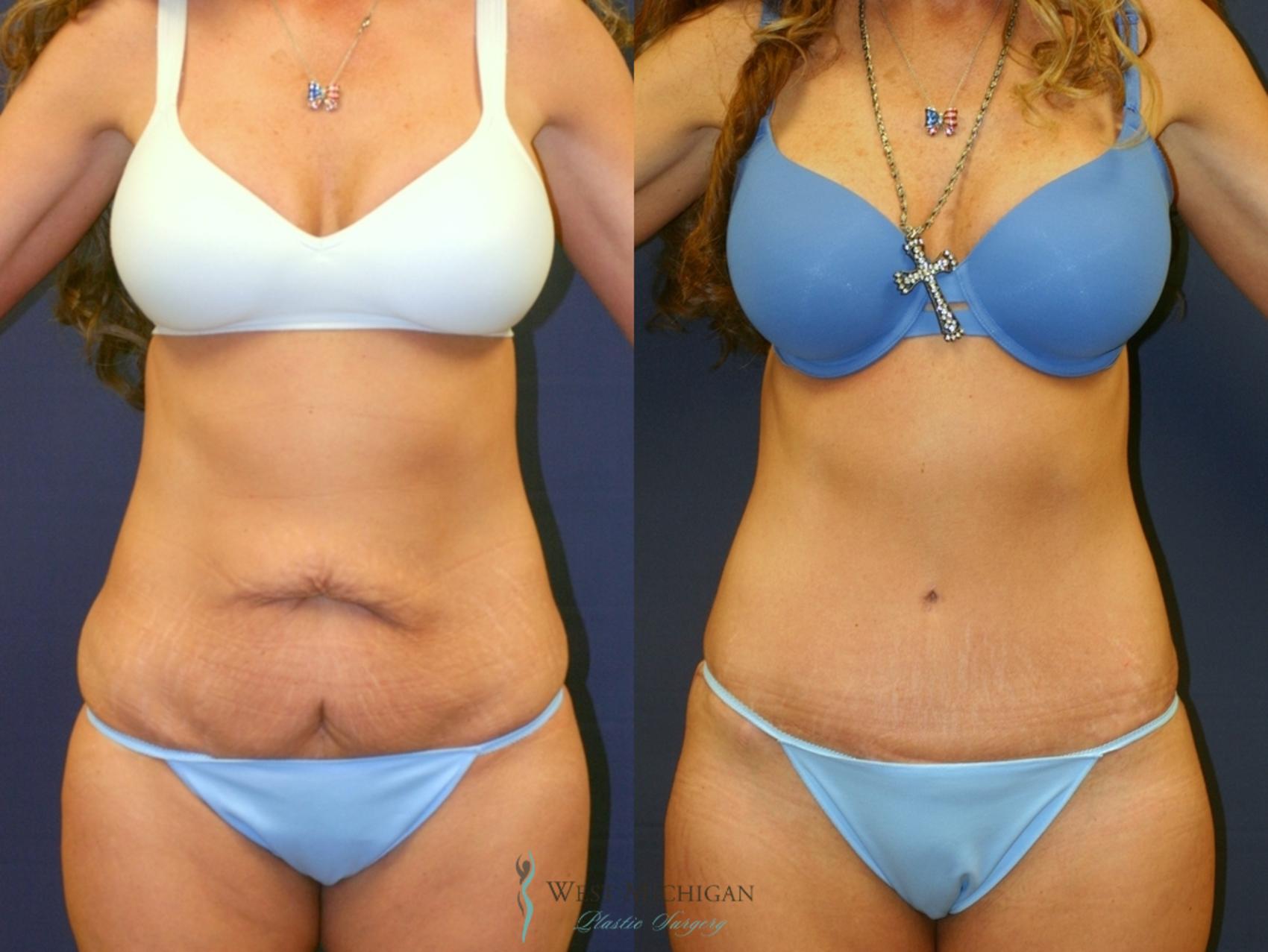A standard tummy tuck scar is a straight horizontal line that spans the lower abdomen between the hip bones just above the pubic area. A mini tummy tuck scar is shorter and may be between 3 and 6 inches. An extended tummy tuck incision is longer, extending around the flanks.
A tummy tuck is a transformative procedure that can dramatically improve the appearance of your abdomen. Patients overwhelmingly believe that the benefits are worth the resulting tummy tuck scar.
In this blog post, we’ll explain what to expect, including where I place the incision, the stages of tummy tuck scar healing, and how to minimize the appearance of scars through proper incision care.
Where Is the Incision?
I take pride in making tummy tuck incisions low enough to be concealed by bikini bottoms. The incision should be just above the pubic area and precise and straight. Different approaches to abdominoplasty result in different scars. Regardless of the technique, a tummy tuck involves removing excess skin and fat to improve the abdominal contours. A traditional tummy tuck also tightens the underlying abdominal muscles if they’ve been separated during pregnancy.
The surgical approach I use depends on your unique needs and goals. There are 3 types of tummy tucks, and the scar’s length varies for each one.
Full (Traditional) Tummy Tuck: A traditional or full tummy tuck involves making a horizontal incision that runs from hip to hip, just above the pubic area. Additionally, I make a second incision around the navel to release the overlying skin. During the procedure, I repair and tighten abdominal muscles, remove excess skin, and create a new opening for the belly button before closing the incisions and inserting surgical drains. Liposuction is typically part of the tummy tuck surgery to sculpt attractive contours.
Short Scar (Mini) Tummy Tuck: A mini tummy tuck focuses on the area below the navel and uses a shorter incision. The resulting scar is typically limited to a horizontal line just above the pubic area, similar to a C-section scar. This procedure does not involve an incision around the navel. Even though the mini tummy tuck scar is shorter than what results after a full tummy tuck, this approach is often not the best solution for patients.
Extended tummy tuck: Many abdominoplasty patients require contouring on the flanks and lower back, in addition to the abdominal area. An extended tummy tuck is similar to a lower body lift and involves extending the tummy tuck incision around the flanks.
Tummy Tuck Before and After Photos
Are Tummy Tuck Scars Permanent?
Whenever an incision is made or your skin sustains a wound, the body’s healing process results in a scar. Even though they fade significantly with proper care, scars don’t go away. Seeing tummy tuck scars in before and after photos can be unnerving because of their length and prominence. But the scars gradually fade and the vast majority of our patients (and patients everywhere) believe the scar is well worth the physical transformation produced by a tummy tuck. On the RealSelf website, out of more than 24,000 tummy tuck patient reviews, 95% said the procedure was “worth it.”
Tummy Tuck Scar Healing Stages
So, what will your tummy tuck scar look like after 6 months? Or in a year and beyond? Immediately after surgery, your incisions will appear red and raised. That’s perfectly normal. After the incisions heal, you’ll see the scar change appearance gradually.
Initial Healing (Weeks 1-4): During this crucial phase, it’s essential to follow our post-operative instructions carefully to prevent infection and promote proper healing.
Transitioning Phase (Months 2-6): As the incisions heal and a scar develops, you’ll notice it begins to flatten and fade. The redness will gradually diminish, and the scar may take on a pinkish hue. You may experience some itching or tightness around the incision site, which is normal as the skin and underlying tissues continue to heal.
6 to 12 Months: By the 6-month mark, your tummy tuck scar will have made significant progress in healing. It will likely be flatter and lighter in color compared to its initial appearance. While still visible, the scar should be much less noticeable than in the early weeks after surgery.
After 1 Year: A tummy tuck scar evolves significantly after 12 months. It should now resemble the surrounding skin tone more closely and be relatively flat and smooth. While still visible when looked at closely, most patients find that their scars are easily concealed by underwear or swimwear at this stage.
Minimizing Your Scar’s Appearance
Proper incision care and scar management can greatly reduce the appearance of your tummy tuck scar. Here are some tips for minimizing your scar’s appearance:
- Follow our post-op instructions closely during the initial healing phase. This includes keeping the incision clean and dry; minimizing tension on the incision by sitting semi-reclined and walking stooped over; and not lifting anything heavier than a couple of pounds (including small children).
- Wearing compression garments as directed by your surgeon can help reduce swelling and support the healing tissues, potentially leading to a finer scar.
- Once your incision is healed, you can use silicone-based scar treatments. These can help improve the scar’s appearance by keeping the area hydrated and promoting collagen production.
- Once the scar has healed sufficiently, gently massaging it can help soften the tissue and improve its appearance. Always consult with your surgeon before starting any scar massage regimen.
- Protect your scar from sun exposure, especially during the first year after surgery. Harmful UV rays can cause the scar to darken and become more noticeable.
Can You Get a Tummy Tuck Scar Tattoo?
Yes, it is possible to get a tattoo to cover a tummy tuck scar, but it’s crucial to wait until the scar has fully matured. This typically takes at least 12 to 18 months after surgery. Tattooing over a scar requires special techniques and considerations, so choose an experienced tattoo artist who has worked with scar coverage before.
Choosing a Plastic Surgeon
The appearance of your tummy tuck scar is significantly influenced by your plastic surgeon’s skill. A board-certified plastic surgeon with extensive experience in tummy tucks will:
- Use advanced techniques tissue dissection and wound closure techniques to minimize scarring
- Place the incision in an optimal location for concealment
- Provide detailed post-operative care instructions to promote proper healing
You can read more about what to look for when choosing a plastic surgeon in our previous blog post.
Take the Next Step
As a board-certified plastic surgeon with extensive experience performing body contouring surgery such as tummy tucks, I look forward to meeting with you to discuss your concerns and aesthetic goals. You can request a consultation using the online form or call our office at (269) 222-1611 to schedule an appointment.








